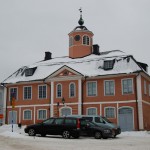Porvoo
In the end of January of 2011, while travelling in Finland, I visited the city of Porvoo, which is one of the most ancient and beautiful cities of Finland.
Porvoo (Swedish — Borgo) is a community in Finland and a small city 50 kilometers east of Helsinki. It is the oldest city of Finland after Turku. The Swedish name of the city is Borgo (it means “fortress on a river”). But since the Finns do not like voiced consonants, they changed Borgo into Porvoo to match their tradition.
The coat of arms of the city is a silver stylized letter C from Latin Castellum (fortress) and it is known since 1423.
The city of Porvoo is for the first time mentioned in chronicles of XIV century. Until 1809, the city was part of the Swedish kingdom. Since 1809, after Russia’s victory in Russian-Swedish war of 1808-1809, the city became part of the Great Princedom of Finland related to the Russian Emperors’ House by a personal union. After 1917, it became part of independent Finland. The city became well-known in Russia and around the world when on March 10—July 7 of 1809, Russian Emperor Alexander I summoned in it the Borgo Sejm, which established large autonomy for Finnish people. The sejm actually created a national state for the Finns, who before that had been in colonial dependence to the Swedish crown, and thus, in general played historically a progressive role in spite of protecting the rights of the Swedish elite both in Finland and Porvoo itself.
In Porvoo Alexander met charming Ulla Mollersward. Passion between them grew at such a speed that Ulla eventually followed the tsar to Russia. Ulla’s fan and Alexander’s cart can be today seen in the History Museum of Porvoo.
Porvoo is a center of Finnish culture. For hundreds of years, this city attracted artists, musicians and poets by its unique charm. There are many places of interest here as well as items with legends in their background. Kings and tsars, priests and well-to-do citizens, artists and pilgrims travelled along the King’s Way from Turku to Porvoo and further to Vyborg and Saint-Petersburg as early as in XIV century. And today, Porvoo is an idyllic, unique place that warmly welcomes tourists from both Finland and other countries.
The most popular and visited places in Porvoo are the Old City and the Virgin Mary Cathedral. Construction of a stone church on that site begun in the end of XIII century; after reconstruction in XV century, it acquired its today’s appearance. Only two walls are preserved from the earliest construction, while all the rest was carefully reconstructed. The church several times burned in fires and was destroyed. In 1508, it was destroyed by Danes; in 1571 and 1590, it was set on fire by Russians. In 1708, during the Northern War the church burned down once again. In 1723, the church cathedra was moved here from Vyborg, which was given to Russia, and the church in Porvoo became a cathedral. The last time the cathedral burned was on May 29, 2006. During the last fire it was almost completely burned; what remained of it crashed down into the inner part of the building. The cathedral was once again restored.
A simple walk around this area is already a pleasant pastime. Old Porvoo is famous for its narrow winding little streets and houses of brick colour on the sea shore.
In the part of the city, which was built in Empire style, low wooden houses form squares according to the classical layout of a city. It is here where the house of the greatest Finnish-Swedish poet Johan Ludvig Runeberg is located being also one of the desirable places for tourist visitations.
In the center of Old Porvoo, by the cathedral, there is a fancy wood log house of XVIII century, in which the famous Wanha Laamanni restaurant has been located for 25 years already. From the open terrace of the restaurant one can admire the grandiose view of the city. In a snail restaurant “Timbaali,” where snails are served, these mollusks are cultivated right in the kitchen. The ship-restaurant “Glukauf” is also of note — a steam boat with а sailing mast of unique construction was remodeled for it.
Porvoo is renowned for its Baltic herring, which is recognized to be a delicious delicacy. In 1998, an award for making the best Baltic herring of spiced salting was given to a dweller of this city. In nearby villages of Epoo and Pellinki in the summer small bazaars are held, where one can always buy fish and farmers’ bread.
The symbol and the main souvenir of Porvoo is a measure cup with double bottom. According to an old legend, a long time ago a king’s governor used to live in the city; he came up with a cunning vessel with double bottom for collecting taxes — grain and vodka. As he was giving the taxes to the country’s treasury, the governor emptied the cup upside down the wrong side, part of the cups content at the same time remained in a secret section.
An interesting tradition has to do with Porvoo. Since 1950s, in Finnish schools the most joyful and kindest pupils were awarded with figures of smiling girls and boys. The contest is held by pupils themselves. All the figures — there are made tens of thousands of them — are cast in Pirkko Kjarijainen’s workshop.

